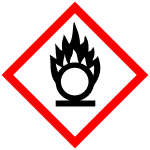12053-18-8
| Name | oxocopper,oxo(oxochromiooxy)chromium |
|---|---|
| Synonyms |
EINECS 235-000-1
chromia Copper Chromite Catalyst MFCD00044868 Copperchromium oxide Cooper Chromite |
| Molecular Formula | CrCuO3 |
|---|---|
| Molecular Weight | 163.54000 |
| Exact Mass | 162.85500 |
| PSA | 63.19000 |
| Storage condition | 2-8℃ |
Synonym:Copper chromite; Chromium (III) copper (II) oxide Section 2 - COMPOSITION, INFORMATION ON INGREDIENTS
Risk Phrases: 20/21 Section 3 - HAZARDS IDENTIFICATION EMERGENCY OVERVIEW
Harmful by inhalation and in contact with skin. Potential Health Effects Eye: Causes eye irritation. May cause chemical conjunctivitis. Skin: Causes skin irritation. May be harmful if absorbed through the skin. Ingestion: May cause gastrointestinal irritation with nausea, vomiting and diarrhea. May be harmful if swallowed. Inhalation: Causes respiratory tract irritation. Can produce delayed pulmonary edema. May cause irritation of the mucous membranes. Chronic: Effects may be delayed. Section 4 - FIRST AID MEASURES Eyes: Immediately flush eyes with plenty of water for at least 15 minutes, occasionally lifting the upper and lower eyelids. Get medical aid. Skin: Get medical aid. Flush skin with plenty of water for at least 15 minutes while removing contaminated clothing and shoes. Wash clothing before reuse. Ingestion: Never give anything by mouth to an unconscious person. Get medical aid. Do NOT induce vomiting. If conscious and alert, rinse mouth and drink 2-4 cupfuls of milk or water. Inhalation: Remove from exposure and move to fresh air immediately. If not breathing, give artificial respiration. If breathing is difficult, give oxygen. Get medical aid. Notes to Physician: Treat symptomatically and supportively. Section 5 - FIRE FIGHTING MEASURES General Information: As in any fire, wear a self-contained breathing apparatus in pressure-demand, MSHA/NIOSH (approved or equivalent), and full protective gear. During a fire, irritating and highly toxic gases may be generated by thermal decomposition or combustion. Substance is noncombustible. Extinguishing Media: Use water spray, dry chemical, carbon dioxide, or appropriate foam. Section 6 - ACCIDENTAL RELEASE MEASURES General Information: Use proper personal protective equipment as indicated in Section 8. Spills/Leaks: Clean up spills immediately, observing precautions in the Protective Equipment section. Sweep up or absorb material, then place into a suitable clean, dry, closed container for disposal. Avoid generating dusty conditions. Provide ventilation. Section 7 - HANDLING and STORAGE Handling: Minimize dust generation and accumulation. Avoid contact with eyes, skin, and clothing. Keep container tightly closed. Avoid ingestion and inhalation. Use with adequate ventilation. Wash clothing before reuse. Storage: Store in a tightly closed container. Store in a cool, dry, well-ventilated area away from incompatible substances. Section 8 - EXPOSURE CONTROLS, PERSONAL PROTECTION Engineering Controls: Facilities storing or utilizing this material should be equipped with an eyewash facility and a safety shower. Use adequate general or local exhaust ventilation to keep airborne concentrations below the permissible exposure limits. Exposure Limits CAS# 12053-18-8: Personal Protective Equipment Eyes: Wear appropriate protective eyeglasses or chemical safety goggles as described by OSHA's eye and face protection regulations in 29 CFR 1910.133 or European Standard EN166. Skin: Wear appropriate protective gloves to prevent skin exposure. Clothing: Wear appropriate protective clothing to prevent skin exposure. Respirators: A respiratory protection program that meets OSHA's 29 CFR 1910.134 and ANSI Z88.2 requirements or European Standard EN 149 must be followed whenever workplace conditions warrant respirator use. Section 9 - PHYSICAL AND CHEMICAL PROPERTIES Physical State: Powder Color: black Odor: Not available. pH: Not available. Vapor Pressure: Not available. Viscosity: Not available. Boiling Point: Not available. Freezing/Melting Point: Not available. Autoignition Temperature: Not available. Flash Point: Not available. Explosion Limits, lower: Not available. Explosion Limits, upper: Not available. Decomposition Temperature: Solubility in water: Specific Gravity/Density: Molecular Formula: Molecular Weight: Section 10 - STABILITY AND REACTIVITY Chemical Stability: Stable at room temperature in closed containers under normal storage and handling conditions. Conditions to Avoid: Incompatible materials, dust generation, excess heat. Incompatibilities with Other Materials: Reducing agents. Hazardous Decomposition Products: Nature of decomposition products unknown.. Hazardous Polymerization: Has not been reported Section 11 - TOXICOLOGICAL INFORMATION RTECS#: CAS# 12053-18-8 unlisted. LD50/LC50: Not available. Carcinogenicity: Copper chromite, barium promoted - Not listed by ACGIH, IARC, or NTP. Section 12 - ECOLOGICAL INFORMATION Other No information available. Section 13 - DISPOSAL CONSIDERATIONS Dispose of in a manner consistent with federal, state, and local regulations. Section 14 - TRANSPORT INFORMATION IATA Shipping Name: DYE INTERMEDIATE, SOLID, TOXIC, N.O.S.* Hazard Class: 6.1 UN Number: 3143 Packing Group: III IMO Shipping Name: DYE INTERMEDIATE, SOLID, TOXIC, N.O.S. Hazard Class: 6.1 UN Number: 3143 Packing Group: III RID/ADR Shipping Name: DYE INTERMEDIATE, SOLID, TOXIC, N.O.S. Hazard Class: 6.1 UN Number: 3143 Packing group: III Section 15 - REGULATORY INFORMATION European/International Regulations European Labeling in Accordance with EC Directives Hazard Symbols: XN Risk Phrases: R 20/21 Harmful by inhalation and in contact with skin. Safety Phrases: S 23 Do not inhale gas/fumes/vapour/spray. WGK (Water Danger/Protection) CAS# 12053-18-8: No information available. Canada None of the chemicals in this product are listed on the DSL/NDSL list. CAS# 12053-18-8 is not listed on Canada's Ingredient Disclosure List. US FEDERAL TSCA CAS# 12053-18-8 is not listed on the TSCA inventory. It is for research and development use only. SECTION 16 - ADDITIONAL INFORMATION N/A |
| Symbol |



GHS03, GHS07, GHS09 |
|---|---|
| Signal Word | Danger |
| Hazard Statements | H272-H335-H410 |
| Precautionary Statements | P220-P261-P273 |
| Personal Protective Equipment | dust mask type N95 (US);Eyeshields;Faceshields;full-face particle respirator type N100 (US);Gloves;respirator cartridge type N100 (US);type P1 (EN143) respirator filter;type P3 (EN 143) respirator cartridges |
| Hazard Codes | O,Xi,T |
| Risk Phrases | 8-37-22-49-50 |
| Safety Phrases | 17-45-53-61 |
| RIDADR | UN 1479 5.1/PG 2 |
| HS Code | 2841500000 |
| HS Code | 2841500000 |
|---|
